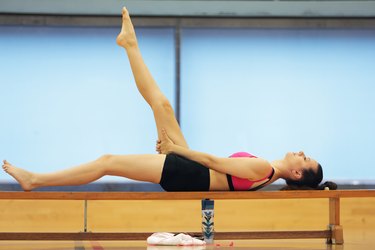
A Baker's cyst can occur for many reasons. In some cases, it may even disappear on its own. However, if it doesn't, certain exercises and stretches for a Baker's cyst can help you manage your symptoms.
Video of the Day
Video of the Day
Managing a Baker's Cyst
Baker's cysts, which are also known as popliteal cysts or popliteal synovial cysts, are fluid-filled cysts found in the back of your knee. According to the Mayo Clinic, these cysts are usually caused by a problem related to your knee joint.
However, the exact nature of the problem can vary. According to a July 2015 study in Sports Health, Baker's cysts can occur due to injuries, like meniscus or anterior cruciate ligament (ACL) tears. They can also be caused by certain health issues, like osteoarthritis and inflammatory arthritis.
Harvard Health Publishing states that Baker's cysts can sometimes have no symptoms. You might not notice that they're there, or you might simply feel a bulge in the back of your knee.
However, in other cases, the cyst can be so large that it impairs your knee's range of motion. Baker's cysts can also cause stiffness, inflammation and pain.
In these cases, your doctor may recommend injecting steroids, draining the cyst or even surgically removing it. However, it's likely that they'll first ask you to try and use physical therapy strategies to reduce symptoms. Meniscus tears are one of the most common causes of a Baker's cyst, so your medical practitioner may also recommend specific exercises for damaged knee cartilage as part of your Baker's cyst exercise strategies.
Baker's Cyst Exercise Strategies
According to the Mayo Clinic, certain exercises can help reduce the unpleasant symptoms associated with your Baker's cyst. However, this doesn't mean that you should perform just any exercise.
Harvard Health Publishing recommends avoiding exercises like jogging, running, tennis and other high-impact activities. Instead, try exercises that can help strengthen your knee muscles. Gentle, non-weight-bearing exercises can also be very helpful and can help increase your mobility.
A good Baker's cyst exercise will strengthen your knee muscles and reduce the stress that's placed on your knee joint. The American Academy of Orthopaedic Surgeons recommends strengthening exercises like hamstring curls, calf raises, leg extensions and straight leg raises.
Your mobility might be too limited to try these exercises straight off the bat. Additionally, pain can occur when you bend or extend the knee with the Baker's cyst. This might make you want to stop moving your leg entirely.
However, not moving your knee can cause stiffness. The July 2015 Sports Health study consequently recommends focusing on exercises that can help maintain your knee's flexibility.
Stretches for a Baker's cyst include the supine hamstring stretch, standing quadriceps stretch and heel cord stretch. If you're really having difficulty with your range of motion, you can also try more basic knee stretches.
Just laying on your stomach and bending your knee back and forth can help stretch your knee muscles and increase your mobility. Similarly, putting a rolled-up towel under your ankle when you're laying down and gradually straightening your leg can help you fully straighten your knee.
If you're having difficulty managing your symptoms despite performing the appropriate exercises and stretches for a Baker's cyst, you should consult with your doctor or physical therapist. They can help you combine Baker's cyst exercise strategies with other pain-management strategies, like icing, compression wraps or steroids, which can help reduce the swelling and inflammation around your knee.
- Mayo Clinic: "Baker's Cyst"
- Kaiser Permanente: "Tips and Exercises for Your Knee Stiffness and Pain"
- American Academy of Orthopaedic Surgeons: "Knee Conditioning Program"
- Harvard Health Publishing: "Ask the Doctor: How Do You Treat a Baker's Cyst?"
- Sports Health: "Baker’s Cyst: Diagnostic and Surgical Considerations"
Is this an emergency? If you are experiencing serious medical symptoms, please see the National Library of Medicine’s list of signs you need emergency medical attention or call 911.